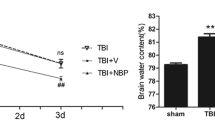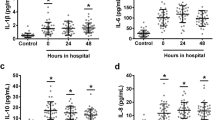Abstract
Traumatic brain injury (TBI) is a major cause of death and disability around the world with no effective treatments currently. The present study was aimed to investigate the neuroprotective effect of licoricidin, one of the major components of licorice extract, on TBI mice and further explore the underlying mechanism. Male C57BL/6 mice were modeled by a modified weight-drop method to mimic TBI. All animals received treatment 30 min after TBI. The modified Neurological Severity Score (NSS) tests were performed at 2 h and 1–3 days after TBI. The brain edema was analyzed by dry–wet weight method. The malonaldehyde (MDA) levels and the activities of glutathione peroxidase (GSH-PX), superoxide dismutase (SOD) and catalase (CAT) were determined by Elisa. Apoptotic neurons were detected using terminal deoxynucleotidyl transferase dUTP nick end labeling (TUNEL) immunofluorescence and the expression of apoptotic proteins were measured by western blot. Activation of the FoxO3/Wnt/β-catenin was evaluated by western blot. The results showed that treatment with licoricidin could significantly decline the NSS scores and reduce the brain edema, hence promote the recovery of neurological function in TBI mice. It also elevated the phosphorylation of p66shc, brought down the levels of MDA, as well as antagonized the decrement in activities of GSH-PX, SOD and CAT induced by TBI. Moreover, licoricidin decreased the TUNEL positive neurons, downregulated the expression of Cyt-C, cleaved-Caspase-3, cleaved-Caspase-9 and Bax and upregulated the Bcl-2, attenuated cellular apoptosis. Licoricidin decreased the expression of FoxO3 and increased the Wnt/β-catenin in TBI mice. In conclusion, Licoricidin exerted neuroprotective effect on TBI model and the effect was possibly due to its antioxidative effect and antiapoptotic effect via regulating the FoxO3/Wnt/β-catenin pathway. Licoricidin may be a candidate drug for TBI therapy.






Similar content being viewed by others
References
Faul M, Coronado V (2015) Epidemiology of traumatic brain injury. Handb Clin Neurol 127:3–13
Gardner RC, Yaffe K (2015) Epidemiology of mild traumatic brain injury and neurodegenerative disease. Mol Cell Neurosci 66(Pt B):75–80
Iaccarino C, Carretta A, Nicolosi F, Morselli C (2018) Epidemiology of severe traumatic brain injury. J Neurosurg Sci 62(5):535–541
Loane DJ, Faden AI (2010) Neuroprotection for traumatic brain injury: translational challenges and emerging therapeutic strategies. Trends Pharmacol Sci 31(12):596–604
Anthonymuthu TS, Kenny EM, Bayir H (2016) Therapies targeting lipid peroxidation in traumatic brain injury. Brain Res 1640(Pt A):57–76
Simon DW, McGeachy MJ, Bayir H, Clark RS, Loane DJ, Kochanek PM (2017) The far-reaching scope of neuroinflammation after traumatic brain injury. Nat Rev Neurol 13(3):171–191
Chen Y, Meng J, Xu Q, Long T, Bi F, Chang C, Liu W (2019) Rapamycin improves the neuroprotection effect of inhibition of NLRP3 inflammasome activation after TBI. Brain Res 1710:163–172
Abdul-Muneer PM, Chandra N, Haorah J (2015) Interactions of oxidative stress and neurovascular inflammation in the pathogenesis of traumatic brain injury. Mol Neurobiol 51(3):966–979
Hergenroeder GW, Redell JB, Moore AN, Dash PK (2008) Biomarkers in the clinical diagnosis and management of traumatic brain injury. Mol Diagn Ther 12(6):345–358
La VD, Tanabe S, Bergeron C, Gafner S, Grenier D (2011) Modulation of matrix metalloproteinase and cytokine production by licorice isolates licoricidin and licorisoflavan A: potential therapeutic approach for periodontitis. J Periodontol 82(1):122–128
Yang R, Wang LQ, Yuan BC, Liu Y (2015) The pharmacological activities of licorice. Planta Med 81(18):1654–1669
Ji S, Tang S, Li K, Li Z, Liang W, Qiao X, Wang Q, Yu S, Ye M (2017) Licoricidin inhibits the growth of SW480 human colorectal adenocarcinoma cells in vitro and in vivo by inducing cycle arrest, apoptosis and autophagy. Toxicol Appl Pharmacol 326:25–33
Tanabe S, Desjardins J, Bergeron C, Gafner S, Villinski JR, Grenier D (2012) Reduction of bacterial volatile sulfur compound production by licoricidin and licorisoflavan A from licorice. J Breath Res 6(1):16006
Wang J, Chen X, Wang W, Zhang Y, Yang Z, Jin Y, Ge HM, Li E, Yang G (2013) Glycyrrhizic acid as the antiviral component of Glycyrrhiza uralensis Fisch. against coxsackievirus A16 and enterovirus 71 of hand foot and mouth disease. J Ethnopharmacol 147(1):114–121
Fu Y, Zhou E, Wei Z, Liang D, Wang W, Wang T, Guo M, Zhang N, Yang Z (2014) Glycyrrhizin inhibits the inflammatory response in mouse mammary epithelial cells and a mouse mastitis model. Febs J 281(11):2543–2557
Fontes LB, Dos SDD, de Carvalho LS, Mesquita HL, Da SRL, Dias AT, Da SFA, Do ACJ (2014) Immunomodulatory effects of licochalcone A on experimental autoimmune encephalomyelitis. J Pharm Pharmacol 66(6):886–894
Hosseinzadeh H, Nassiri-Asl M (2015) Pharmacological effects of Glycyrrhiza spp. and its bioactive constituents: update and review. Phytother Res 29(12):1868–1886
Shan L, Zhang G, Guo Z, Shi X (2019) In vitro investigation of permeability and metabolism of licoricidin. Life Sci 234:116770
Sakr SA, Shalaby SY (2014) Carbendazim-induced testicular damage and oxidative stress in albino rats: ameliorative effect of licorice aqueous extract. Toxicol Ind Health 30(3):259–267
Flierl MA, Stahel PF, Beauchamp KM, Morgan SJ, Smith WR, Shohami E (2009) Mouse closed head injury model induced by a weight-drop device. Nat Protoc 4(9):1328–1337
Nicolai B, Schierhorn H (1981) Comparison of the developing temporal neocortex with the sensorimotor cortex in rats. Brain Res 211(1):67–77
Germano AF, Dixon CE, D'Avella D, Hayes RL, Tomasello F (1994) Behavioral deficits following experimental subarachnoid hemorrhage in the rat. J Neurotrauma 11(3):345–353
Chen J, Li Y, Wang L, Zhang Z, Lu D, Lu M, Chopp M (2001) Therapeutic benefit of intravenous administration of bone marrow stromal cells after cerebral ischemia in rats. Stroke 32(4):1005–1011
Liu Z, Wang H, Shi X, Li L, Zhou M, Ding H, Yang Y, Li X, Ding K (2017) DL-3-n-Butylphthalide (NBP) Provides Neuroprotection in the mice models after traumatic brain injury via Nrf2-ARE signaling pathway. Neurochem Res 42(5):1375–1386
Li XJ, Liang L, Shi HX, Sun XP, Wang J, Zhang LS (2017) Neuroprotective effects of curdione against focal cerebral ischemia reperfusion injury in rats. Neuropsychiatr Dis Treat 13:1733–1740
Pellegrini M, Baldari CT (2009) Apoptosis and oxidative stress-related diseases: the p66Shc connection. Curr Mol Med 9(3):392–398
Galimov ER (2010) The role of p66shc in oxidative stress and apoptosis. Acta Naturae 2(4):44–51
Essers MA, de Vries-Smits LM, Barker N, Polderman PE, Burgering BM, Korswagen HC (2005) Functional interaction between beta-catenin and FOXO in oxidative stress signaling. Science 308(5725):1181–1184
Hoogeboom D, Essers MA, Polderman PE, Voets E, Smits LM, Burgering BM (2008) Interaction of FOXO with beta-catenin inhibits beta-catenin/T cell factor activity. J Biol Chem 283(14):9224–9230
Zhang JY, Lee JH, Gu X, Wei ZZ, Harris MJ, Yu SP, Wei L (2018) Intranasally delivered Wnt3a improves functional recovery after traumatic brain injury by modulating autophagic, apoptotic, and regenerative pathways in the mouse brain. J Neurotrauma 35(5):802–813
Dixon KJ (2017) Pathophysiology of traumatic brain injury. Phys Med Rehabil Clin N Am 28(2):215–225
Abe H, Shimoji K, Nagamine Y, Fujiwara S, Izumi SI (2017) Predictors of recovery from traumatic brain injury-induced prolonged consciousness disorder. Neural Plast 2017:9358092
Blennow K, Hardy J, Zetterberg H (2012) The neuropathology and neurobiology of traumatic brain injury. Neuron 76(5):886–899
Kaur P, Sharma S (2018) Recent advances in pathophysiology of traumatic brain injury. Curr Neuropharmacol 16(8):1224–1238
Barkhoudarian G, Hovda DA, Giza CC (2016) The molecular pathophysiology of concussive brain injury: an update. Phys Med Rehabil Clin N Am 27(2):373–393
Ansari MA, Roberts KN, Scheff SW (2008) Oxidative stress and modification of synaptic proteins in hippocampus after traumatic brain injury. Free Radic Biol Med 45(4):443–452
Ansari MA, Roberts KN, Scheff SW (2008) A time course of contusion-induced oxidative stress and synaptic proteins in cortex in a rat model of TBI. J Neurotrauma 25(5):513–526
Yao K, Ye P, Zhang L, Tan J, Tang X, Zhang Y (2008) Epigallocatechin gallate protects against oxidative stress-induced mitochondria-dependent apoptosis in human lens epithelial cells. Mol Vis 14:217–223
Drose S, Stepanova A (1857) Galkin A (2016) Ischemic A/D transition of mitochondrial complex I and its role in ROS generation. Biochim Biophys Acta 7:946–957
Chen X, Pan Z, Fang Z, Lin W, Wu S, Yang F, Li Y, Fu H, Gao H, Li S (2018) Omega-3 polyunsaturated fatty acid attenuates traumatic brain injury-induced neuronal apoptosis by inducing autophagy through the upregulation of SIRT1-mediated deacetylation of Beclin-1. J Neuroinflammation 15(1):310
Gao YY, Zhang ZH, Zhuang Z, Lu Y, Wu LY, Ye ZN, Zhang XS, Chen CL, Li W, Hang CH (2018) Recombinant milk fat globule-EGF factor-8 reduces apoptosis via integrin beta3/FAK/PI3K/AKT signaling pathway in rats after traumatic brain injury. Cell Death Dis 9(9):845
He H, Li X, He Y (2019) Hyperbaric oxygen therapy attenuates neuronal apoptosis induced by traumatic brain injury via Akt/GSK3beta/beta-catenin pathway. Neuropsychiatr Dis Treat 15:369–374
Tapia JC, Torres VA, Rodriguez DA, Leyton L, Quest AF (2006) Casein kinase 2 (CK2) increases survivin expression via enhanced beta-catenin-T cell factor/lymphoid enhancer binding factor-dependent transcription. Proc Natl Acad Sci U S A 103(41):15079–15084
Liu H, Yin J, Wang H, Jiang G, Deng M, Zhang G, Bu X, Cai S, Du J, He Z (2015) FOXO3a modulates WNT/beta-catenin signaling and suppresses epithelial-to-mesenchymal transition in prostate cancer cells. Cell Signal 27(3):510–518
Liu H, Zhou BH, Qiu X, Wang HS, Zhang F, Fang R, Wang XF, Cai SH, Du J, Bu XZ (2012) T63, a new 4-arylidene curcumin analogue, induces cell cycle arrest and apoptosis through activation of the reactive oxygen species-FOXO3a pathway in lung cancer cells. Free Radic Biol Med 53(12):2204–2217
Yoo KY, Kwon SH, Lee CH, Yan B, Park JH, Ahn JH, Choi JH, Ohk TG, Cho JH, Won MH (2012) FoxO3a changes in pyramidal neurons and expresses in non-pyramidal neurons and astrocytes in the gerbil hippocampal CA1 region after transient cerebral ischemia. Neurochem Res 37(3):588–595
Wodarz A, Nusse R (1998) Mechanisms of Wnt signaling in development. Annu Rev Cell Dev Biol 14:59–88
Funding
This work was supported by Cuiying Scientific and Technological Innovation Program of Lanzhou University Second Hospital (grant number: CY2018-MS05).
Author information
Authors and Affiliations
Corresponding author
Ethics declarations
Conflicts of interest
The authors declare that they have no conflict of interest.
Additional information
Publisher's Note
Springer Nature remains neutral with regard to jurisdictional claims in published maps and institutional affiliations.
Rights and permissions
About this article
Cite this article
Liu, C., He, D. & Zhao, Q. Licoricidin improves neurological dysfunction after traumatic brain injury in mice via regulating FoxO3/Wnt/β-catenin pathway. J Nat Med 74, 767–776 (2020). https://doi.org/10.1007/s11418-020-01434-5
Received:
Accepted:
Published:
Issue Date:
DOI: https://doi.org/10.1007/s11418-020-01434-5




